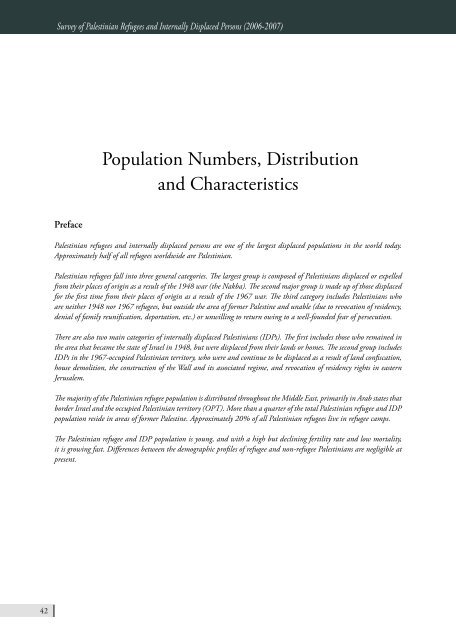BADIL Resource Center for Palestinian Residency and Refugee
BADIL Resource Center for Palestinian Residency and Refugee
BADIL Resource Center for Palestinian Residency and Refugee
You also want an ePaper? Increase the reach of your titles
YUMPU automatically turns print PDFs into web optimized ePapers that Google loves.
42<br />
Survey of <strong>Palestinian</strong> <strong>Refugee</strong>s <strong>and</strong> Internally Displaced Persons (2006-2007)<br />
Preface<br />
Population Numbers, Distribution<br />
<strong>and</strong> Characteristics<br />
<strong>Palestinian</strong> refugees <strong>and</strong> internally displaced persons are one of the largest displaced populations in the world today.<br />
Approximately half of all refugees worldwide are <strong>Palestinian</strong>.<br />
<strong>Palestinian</strong> refugees fall into three general categories. The largest group is composed of <strong>Palestinian</strong>s displaced or expelled<br />
from their places of origin as a result of the 1948 war (the Nakba). The second major group is made up of those displaced<br />
<strong>for</strong> the first time from their places of origin as a result of the 1967 war. The third category includes <strong>Palestinian</strong>s who<br />
are neither 1948 nor 1967 refugees, but outside the area of <strong>for</strong>mer Palestine <strong>and</strong> unable (due to revocation of residency,<br />
denial of family reunification, deportation, etc.) or unwilling to return owing to a well-founded fear of persecution.<br />
There are also two main categories of internally displaced <strong>Palestinian</strong>s (IDPs). The first includes those who remained in<br />
the area that became the state of Israel in 1948, but were displaced from their l<strong>and</strong>s or homes. The second group includes<br />
IDPs in the 1967-occupied <strong>Palestinian</strong> territory, who were <strong>and</strong> continue to be displaced as a result of l<strong>and</strong> confiscation,<br />
house demolition, the construction of the Wall <strong>and</strong> its associated regime, <strong>and</strong> revocation of residency rights in eastern<br />
Jerusalem.<br />
The majority of the <strong>Palestinian</strong> refugee population is distributed throughout the Middle East, primarily in Arab states that<br />
border Israel <strong>and</strong> the occupied <strong>Palestinian</strong> territory (OPT). More than a quarter of the total <strong>Palestinian</strong> refugee <strong>and</strong> IDP<br />
population reside in areas of <strong>for</strong>mer Palestine. Approximately 20% of all <strong>Palestinian</strong> refugees live in refugee camps.<br />
The <strong>Palestinian</strong> refugee <strong>and</strong> IDP population is young, <strong>and</strong> with a high but declining fertility rate <strong>and</strong> low mortality,<br />
it is growing fast. Differences between the demographic profiles of refugee <strong>and</strong> non-refugee <strong>Palestinian</strong>s are negligible at<br />
present.

















